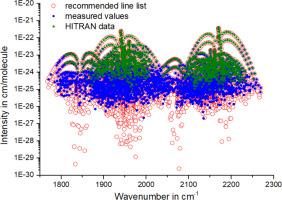New acetylene line list near 5μm - Part I: 12C2H2
IF 1.9
3区 物理与天体物理
Q2 OPTICS
Journal of Quantitative Spectroscopy & Radiative Transfer
Pub Date : 2025-09-16
DOI:10.1016/j.jqsrt.2025.109680
引用次数: 0
Abstract
The spectroscopic knowledge of the 5-µm spectral region of acetylene has been improved from the analysis of Fourier Transform spectra using high optical path length (up to 1 km). In the present work line positions and intensities were investigated for around 4300 transitions belonging to 60 bands of 12C2H2 including 15 bands already present in the HITRAN and GEISA databases. The band centers and the upper level spectroscopic constants were retrieved for all bands. Comparisons of measured line positions and calculated ones (with spectroscopic constants or effective Hamiltonian model) were performed for each band in order to select the best model to retain. The effective dipole moment operator parameters describing intensities observed in the ΔP = 3 spectral region were refined. The measured line positions and intensities have also been compared to the literature data included in the HITRAN and GEISA databases showing a good consistency for most of the bands, except for some bands for which only a few transitions were measured. A complete list of calculated line parameters for 6200 transitions has been generated for 60 bands between 1767 cm−1 and 2267 cm−1 and is available in the HITRAN format as supplementary material of this work.

近5μm的新乙炔线表-第一部分:12C2H2
利用高光程长度(高达1 km)的傅里叶变换光谱分析,提高了对乙炔5µm光谱区域的光谱知识。在目前的工作线上,研究了属于12C2H2 60个波段的大约4300个过渡的位置和强度,其中包括已经在HITRAN和GEISA数据库中存在的15个波段。检索了各波段的光谱中心和上层光谱常数。将每个波段的实测线位置与计算线位置(使用光谱常数或有效哈密顿模型)进行比较,以选择保留的最佳模型。对描述在ΔP = 3光谱区域观测到的强度的有效偶极矩算子参数进行了改进。实测线的位置和强度也与HITRAN和GEISA数据库中的文献数据进行了比较,除了一些只测量了少量过渡的波段外,大多数波段的一致性都很好。在1767 cm−1和2267 cm−1之间的60个波段中,已经生成了6200个跃迁的计算线参数的完整列表,并以HITRAN格式作为本工作的补充材料。
本文章由计算机程序翻译,如有差异,请以英文原文为准。
求助全文
约1分钟内获得全文
求助全文
来源期刊
CiteScore
5.30
自引率
21.70%
发文量
273
审稿时长
58 days
期刊介绍:
Papers with the following subject areas are suitable for publication in the Journal of Quantitative Spectroscopy and Radiative Transfer:
- Theoretical and experimental aspects of the spectra of atoms, molecules, ions, and plasmas.
- Spectral lineshape studies including models and computational algorithms.
- Atmospheric spectroscopy.
- Theoretical and experimental aspects of light scattering.
- Application of light scattering in particle characterization and remote sensing.
- Application of light scattering in biological sciences and medicine.
- Radiative transfer in absorbing, emitting, and scattering media.
- Radiative transfer in stochastic media.

 求助内容:
求助内容: 应助结果提醒方式:
应助结果提醒方式:


